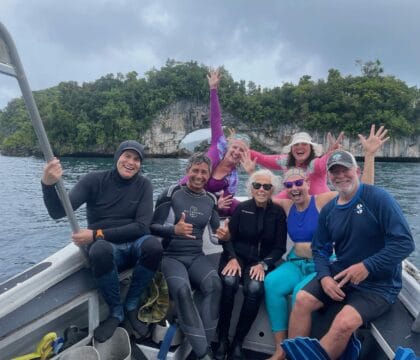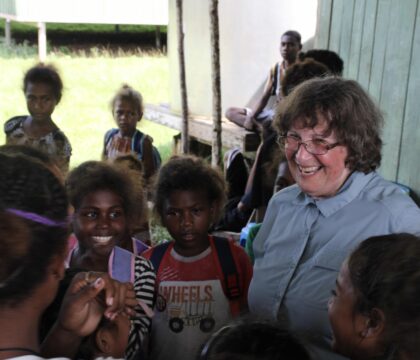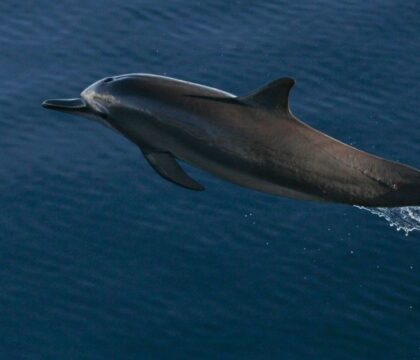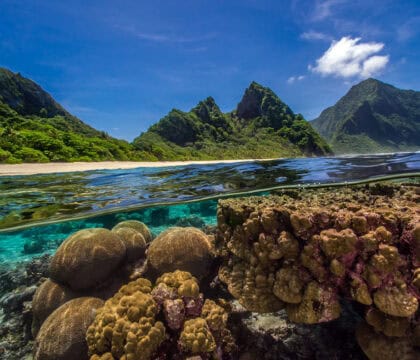July 11, 2025 • Field Notes
Since our 2025 Farallon Islands whale watching season began in early April, we’ve experienced one remarkable day after another off the coast of San Francisco. Each trip to the Farallon Islands has offered unforgettable and close encounters with humpback whales, but a particular pattern has emerged that’s left both our crew and guests stunned: the whales are watching us.
We’re not just seeing whales—we’re being seen by them.
Whale Activity Near the Farallones
So far this season, the marine life around the Farallon Islands has been nothing short of phenomenal. We’ve averaged around eighteen Humpback Whales sightings per outing, often in groups of three to seven, with several breaches and tail throws observed on nearly every trip.
Many of these sightings have taken place just west of the islands, near the edge of the Continental Shelf, where the seafloor drops dramatically from 300 to over 3,000 feet. This steep underwater cliff generates a phenomenon known as coastal upwelling, where deep, cold, nutrient-rich water is pulled to the surface by prevailing winds and ocean currents.
This upwelling creates a biological buffet that supports a diverse array of organisms, ranging from krill and anchovies to seabirds, dolphins, sharks, and, of course, whales.
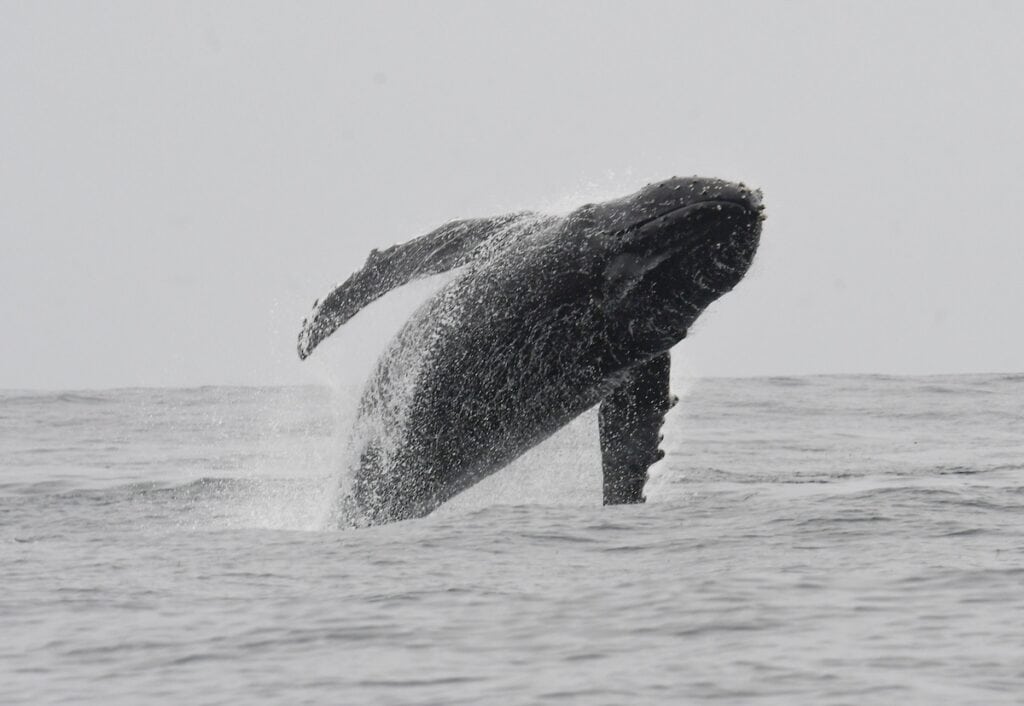
A humpback whale’s powerful leap above the ocean surface, captured in stunning detail by our onboard photographer. © Michael Pierson
Unusual Whale Behavior: Getting “Mugged”
Several times this season, we’ve had encounters that naturalists refer to as being “mugged.”
In the world of whale watching, the term mugging describes a behavior where whales intentionally approach a vessel and remain nearby, sometimes for extended periods. It’s not common—and certainly not guaranteed—but when it happens, it’s unforgettable.
“We’ve had Humpbacks circle the boat multiple times, hang directly beneath the hull, and surface just a few feet away from guests,” says Oceanic Society’s own veteran naturalist, Chris Biertuempfel. “Some linger for 30 to 45 minutes. They’re clearly aware of our presence, and they seem curious.”
These aren’t accidental approaches. The whales appear to be fully aware of us and often seem just as curious as we are.
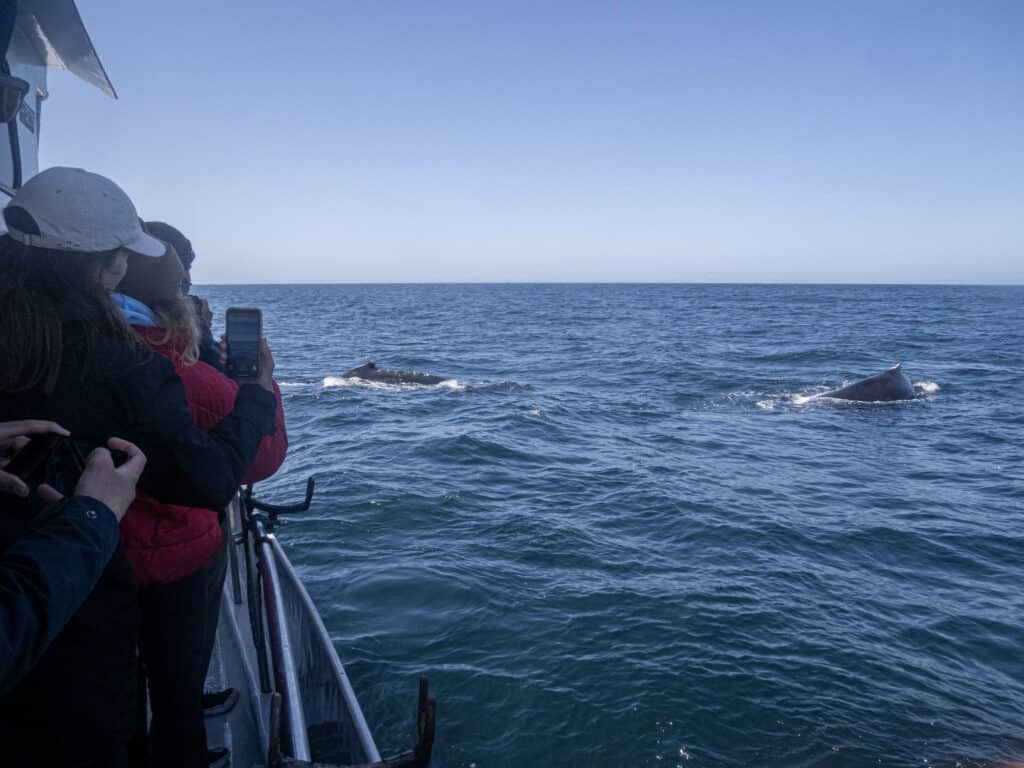
Whale watch passengers excitedly record whales surfaces alongside tour vessel © Anna Krylova
A Closer Look: Spy-Hopping, Flipper Slaps, and Eye Contact
We’ve observed whales spy-hopping—rising vertically out of the water to look around—within feet of the boat. Others have rolled on their sides to expose a flipper or even an eye above the surface. Several guests have described the surreal feeling of being looked at by a whale as it glides past the rail, sometimes appearing to move from person to person.
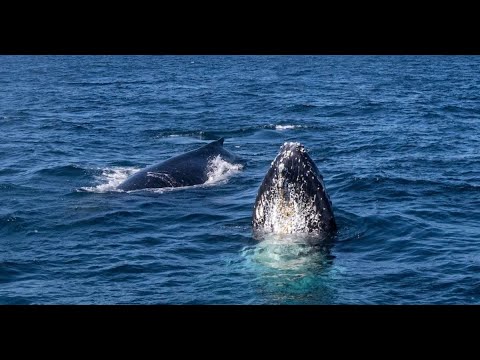
One guest said, “It felt like it was studying us—like we were the ones on display.”
These are slow, quiet moments—no splashing, no rushing. Just steady observation, as if the whales are intentionally choosing to spend time near us. These close encounters with humpback whales offer rare insight into their intelligence and curiosity.
During yet another extraordinary outing, we witnessed a moment that perfectly captured the blend of majesty and relatability that defines these animals. As a Humpback Whale surfaced beside the boat and then slipped beneath the waves, our onboard photographer happened to be filming with an underwater camera. The timing was perfect. As the whale disappeared below the surface, a large bubble rose up behind it—not from the blowhole, but unmistakably from the other end.
Yes, a whale fart caught on camera!
The reaction on board was immediate: laughter, disbelief, and sheer delight. It was the kind of moment that brings people together and reminds us that nature, while awe-inspiring, can also be surprisingly down-to-earth.
Passing gas is a natural part of whale digestion, as krill and fish break down in their massive stomachs. Moments like these bring a relatable, humanizing glimpse into whale life, balancing awe with humor.
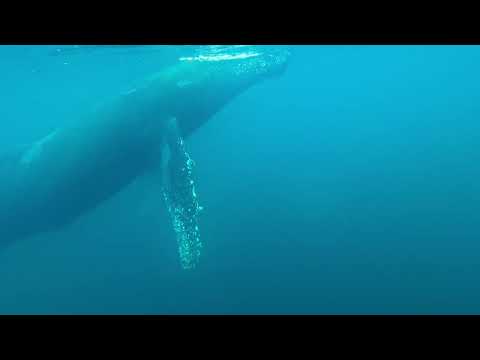
As Oceanic Society’s California Field Operations Specialist, I’ve had the pleasure of joining several hundred trips off the coast over the years. Among them, this season stands out as one of the most remarkable for memorable whale encounters.
Why We’re Seeing This Now
Humpback Whales, in particular, are drawn to these waters each spring and summer to feed after long migrations from their breeding grounds in Mexico and Central America. By April, many have just completed their 3,000-mile journey north, and their arrival often coincides with peak upwelling.
“They’re hungry, social, and in a heightened state of awareness,” explains Biertuempfel . “Some naturalists believe residual hormones from the breeding season—like testosterone and estrogen—might make the whales more interactive or exploratory this time of year.
Combine that with the exceptional food availability near the Continental Shelf, and you have the perfect setting for sustained, close-range encounters. This seasonal overlap—just after their migration and during peak upwelling—makes late spring and early summer one of the absolute best times to take a whale watching trip to the Farallon Islands.
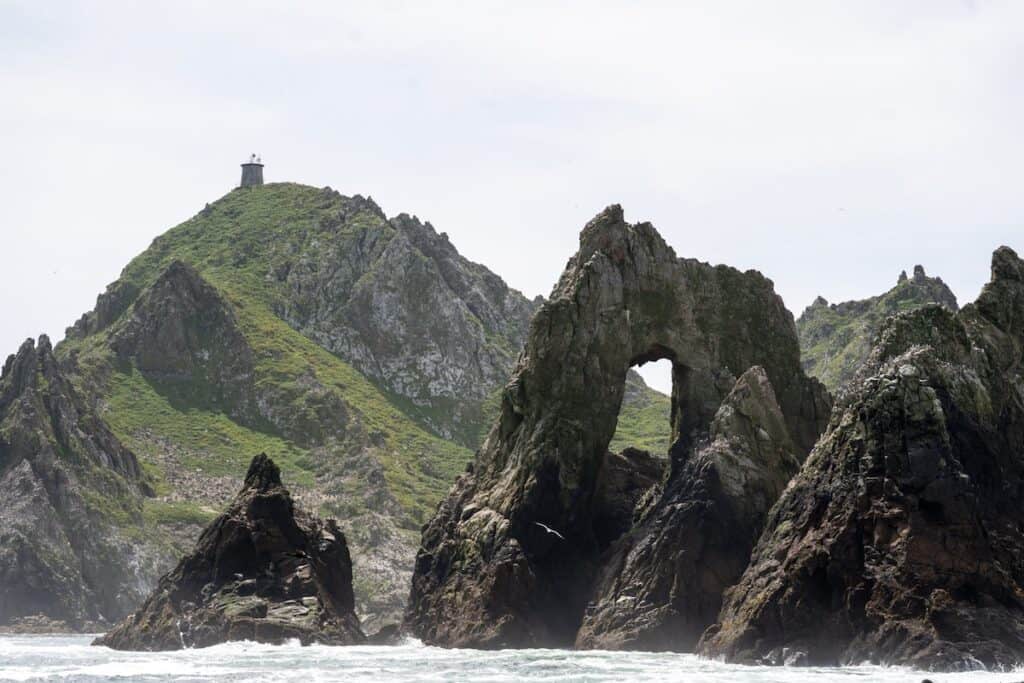
Farallon Island rock formations © Chris Biertuempfel
Guests React to These Close Encounters
These experiences have left a lasting impression on our guests. Some are awestruck, others deeply moved.
“You see them in documentaries and think you understand,” one passenger told us. “But when it happens right in front of you—when a whale looks at you—it changes the way you see the ocean.”
These reactions are exactly why we do what we do. Encounters like this have the power to connect people to the marine world in a personal, emotional way—and that connection often leads to a stronger desire to protect it.
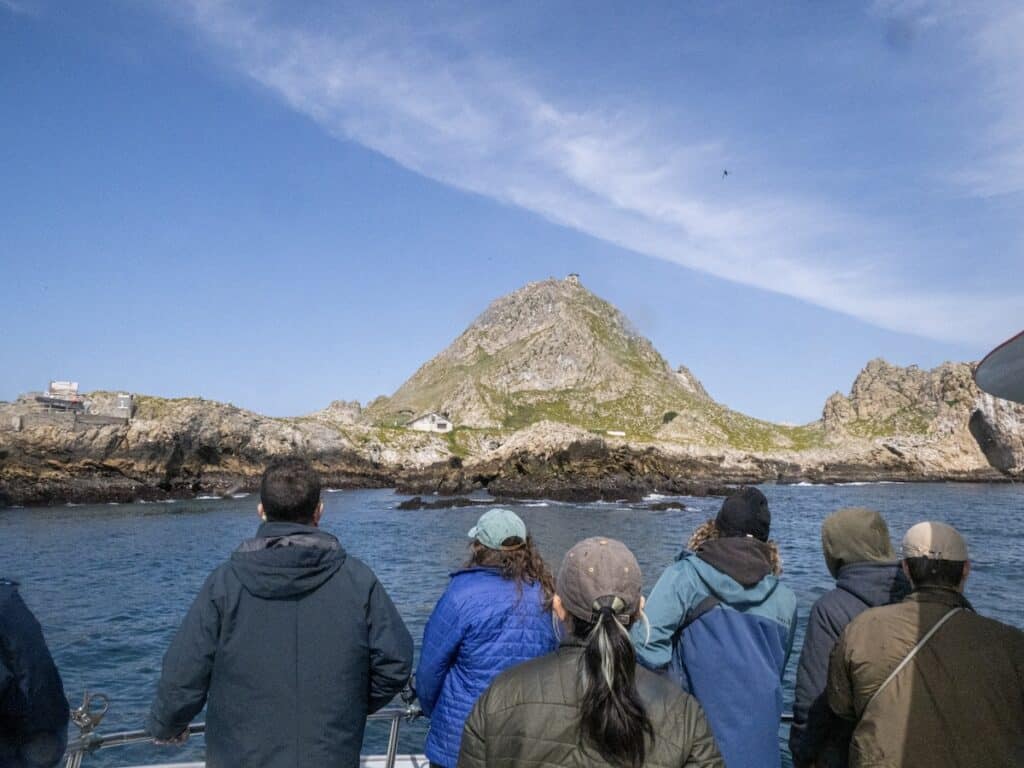
Farallon Islands tour participants gaze into waters and rocky coves to spot wildlife around islands. © Chris Biertuempfel
What These Moments Remind Us
Whale watching isn’t always about action-packed sightings. Sometimes, it’s about the quiet tension of being seen by a wild animal that weighs more than 40 tons—and choosing to stay in that moment with them.
These whales are not just passing through. They are intelligent, social beings with complex behavior and agency. When they choose to engage, we are given the rare opportunity to witness more than wildlife—we’re witnessing relationships.
Biertuempfel shares, “these small, candid moments often leave the biggest impression. They reinforce the importance of observing wildlife respectfully and protecting the habitats that allow such creatures to thrive. Whether it’s a graceful breach, a curious eye at the surface, or even an unexpected bubble, each encounter draws us closer to understanding and appreciating the complex lives of marine animals.”
Interested in joining us for an upcoming trip?
Our spring and summer whale watching tours to the Farallon Islands depart every weekend from San Francisco. Whether you’re traveling with family, hoping to capture breathtaking wildlife photography, or passionate about marine conservation, these trips offer something truly special for everyone.
You’ll encounter playful sea lions, soaring seabirds, and majestic humpback whales—sometimes so close they seem to be watching you back. Each day on the water promises unforgettable moments and the chance to deepen your connection with the ocean’s incredible wildlife.
Join us for a meaningful adventure that’s both fun and educational, perfect for all ages and experience levels.
Don’t miss your chance to make lifelong memories, experience close encounters with humpback whales, and support marine conservation efforts—book your whale watching tour today!
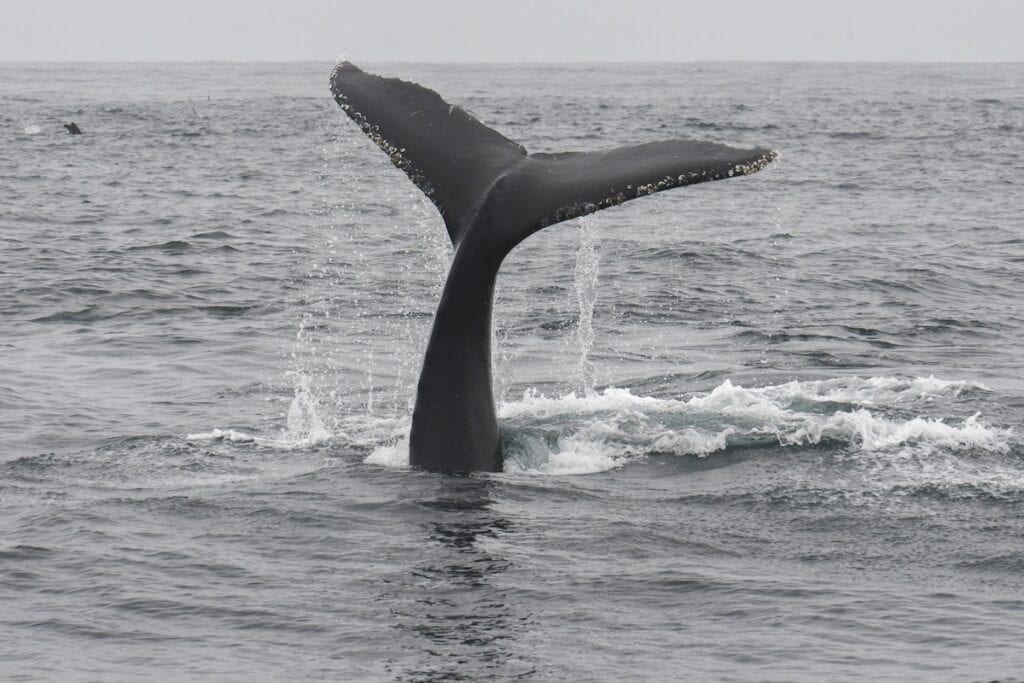
A dramatic snapshot of a humpback’s flukes surfacing and splashing back into the water near the Farallones.© Michael Pierson

